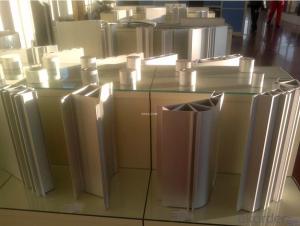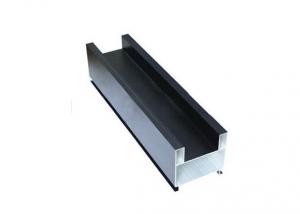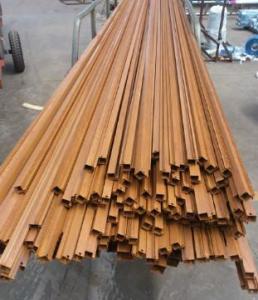Industrial Aluminum Profile for LED Tape Light Strip
- Loading Port:
- China Main Port
- Payment Terms:
- TT OR LC
- Min Order Qty:
- -
- Supply Capability:
- -
OKorder Service Pledge
OKorder Financial Service
You Might Also Like
Industial Aluminum Profile
Alloy: 6063, Temper: T5, T6.
surface:mill finished,anodized3.
widely used for building,furniture,transportation
Industial Aluminum Profile
Alloy: 6063,
Temper: T5, T6.
building,furniture,transportation,machine
Anodized silver, anodized champagne, anodized bronze, anodized black, powder coated, electrophoresis, polished, Thermal break, wooden grain.
Length: 5.8---6 meters, depend on customers' requested.
Packing: kraft paper, carton, or on customers' requested.
Exported to different countries worldwide.
- Q: This question asks about the various types of surface treatments or finishes that can be applied to aluminum profiles.
- <p>Aluminum profiles can be coated with different types of finishes to enhance their appearance, durability, and resistance to corrosion. Some common types of coatings include: 1. Anodizing, which creates a protective oxide layer on the surface. 2. Powder coating, a durable and colorful finish applied through an electrostatic process. 3. Electrophoretic coating, a method that uses electric current to apply a paint-like coating. 4. PVDF coating, a high-performance finish with excellent weather resistance. 5. Thermal spraying, which applies a coating through a high-velocity flame. 6. Vacuum coating, a process that deposits thin layers of material in a vacuum chamber. Each type of coating has specific properties and applications, making them suitable for different environments and uses.</p>
- Q: This question asks for methods to avoid corrosion on aluminum profiles during the installation process.
- <p>To prevent corrosion on aluminum profiles during installation, follow these steps: Use high-quality aluminum that has a protective oxide layer. Ensure the installation environment is dry and clean. Avoid contact with corrosive substances like acids or alkalis. Apply a protective coating or sealant if the profiles will be exposed to harsh environments. Use stainless steel or corrosion-resistant fasteners. Regularly inspect and clean the profiles to remove any dirt or debris that could lead to corrosion. Proper installation techniques and maintenance can significantly reduce the risk of corrosion on aluminum profiles.</p>
- Q: What are the different accessories available for aluminum profiles?
- There are a wide range of accessories available for aluminum profiles that can enhance their functionality and versatility. Some of the common accessories include: 1. T-nuts: T-nuts are used to create threaded connections within aluminum profiles, allowing for easy attachment of various components such as brackets, panels, and fasteners. 2. Corner connectors: These connectors are used to join aluminum profiles at right angles, enabling the creation of sturdy and rigid structures. They come in various designs, such as external or internal corner connectors. 3. End caps: End caps are used to seal the open ends of aluminum profiles, providing a clean and finished look while also protecting against dust, debris, and potential injuries. 4. Brackets and fasteners: Brackets and fasteners are essential accessories for securing and supporting components within aluminum profiles. They come in various shapes and sizes to accommodate different applications. 5. Panel mounts: Panel mounts provide a secure and convenient way to attach panels, boards, or other flat surfaces to aluminum profiles. They can be easily adjusted or removed as needed. 6. Hinges and handles: These accessories are commonly used in applications where doors, lids, or covers need to be attached to aluminum profiles. Hinges allow for smooth opening and closing, while handles provide a comfortable grip. 7. Cable management solutions: Cable management accessories such as cable clips, cable ducts, and cable ties are available to keep wires and cables organized within aluminum profiles, ensuring a neat and professional appearance. 8. Leveling feet and casters: Leveling feet and casters are useful accessories for aluminum profile-based structures that need to be mobile or require stability on uneven surfaces. Leveling feet help adjust the height and ensure stability, while casters provide mobility. 9. LED lighting solutions: Aluminum profiles are often used for LED lighting applications, and various accessories are available to integrate lighting strips, diffusers, and connectors for a seamless and professional lighting solution. 10. Sensors and switches: Accessories like sensor mounts and switch brackets are designed to integrate sensors or switches into aluminum profiles, allowing for easy installation and integration into automation or control systems. These are just a few examples of the many accessories available for aluminum profiles. The wide range of options allows for customization and adaptation to specific needs and applications, making aluminum profiles a versatile and reliable choice for various industries and projects.
- Q: Inquire about the various uses of aluminum profiles within the field of architecture.
- <p>Aluminum profiles have a wide range of applications in architecture due to their strength, durability, and lightweight properties. They are commonly used in curtain walls, which are the exterior coverings of buildings, providing both aesthetic appeal and structural integrity. Aluminum profiles are also utilized in window and door frames for their resistance to corrosion and ability to withstand various weather conditions. They are employed in structural glazing to hold glass in place securely. Furthermore, aluminum profiles are used in sun shading systems to control the amount of sunlight entering a building, enhancing energy efficiency. They are also found in handrails, balustrades, and other safety features for their strength and low maintenance requirements. Overall, aluminum profiles contribute to the sustainability and modern design of architectural projects.</p>
- Q: Can aluminum profiles be used for solar panel mounting systems?
- Yes, aluminum profiles can be used for solar panel mounting systems. Aluminum is a popular choice for solar panel mounting systems due to its numerous advantages. Firstly, aluminum is lightweight, making it easier to handle and install. This is especially important when considering the weight that solar panels can add to a structure. Secondly, aluminum is corrosion-resistant, which is crucial as solar panel mounting systems are exposed to various weather conditions. Additionally, aluminum is a durable material that can withstand high winds, snow loads, and other environmental factors. Furthermore, aluminum profiles can be easily customized and fabricated to fit specific project requirements. They are available in various sizes and shapes, allowing for flexibility in design and installation. Overall, aluminum profiles provide a reliable and efficient solution for solar panel mounting systems.
- Q: This question asks for the standard specifications and measurements of aluminum profiles that are frequently utilized in construction projects.
- <p>Aluminum profiles used in construction come in various specifications and measurements. Commonly, they are categorized by series such as 6060, 6061, 6063, and 6082, each with different mechanical properties. Sizes can range from small profiles like 20x20mm to large ones like 200x200mm or more. Thicknesses typically vary from 1mm to 6mm, depending on the structural requirements. Lengths can be customized but are generally available in standard lengths such as 6 meters. The profiles are measured in terms of their width, height, and thickness, and they are designed to meet specific load-bearing and aesthetic needs in construction. It's important to consult with suppliers or construction specifications for the exact measurements required for a particular project.</p>
- Q: Can aluminum profiles be used for exhibition stands?
- Yes, aluminum profiles can be used for exhibition stands. Aluminum is a popular choice for constructing exhibition stands due to its lightweight nature, durability, and versatility. It allows for easy transportation and assembly, while providing a sleek and professional appearance. Additionally, aluminum profiles can be customized to fit specific design requirements, making them ideal for creating unique and eye-catching exhibition displays.
- Q: How to distinguish the good or bad of aluminum profile simply?
- Then, how to distinguish the aluminum profile is good or bad? Let's get to know those aluminum profiles that are not qualified.First, extrusion defects.Aluminum extrusion process for machine equipment is perfect, process technology is mature and whether the operation staff misconduct and other reasons, will lead to aluminum flakes, such as inclusion, delamination, chromatic aberration, distortion and other defects, affecting the quality of aluminum profiles.Second, the film thickness is thin.Industrial aluminum oxide film thickness standard should be not less than 10um (m). If the thickness is not enough, the surface of the aluminum profile is easy to rust and corrode and shorten the service life. In order to save the cost, the thickness of the oxide film is only 2 to 4um, and some even have no oxide film. It is estimated that each reduction of 1um film thickness can reduce power consumption by more than 150 yuan per ton.
- Q: Can aluminum profiles be used in material handling equipment manufacturing?
- Indeed, aluminum profiles have the capability to be utilized in the manufacturing of material handling equipment. These profiles possess properties such as being lightweight, resistant to corrosion, and exhibiting a high strength-to-weight ratio, thus rendering them suitable for the construction of diverse components in material handling equipment. By means of these profiles, frames, support structures, conveyor systems, and other parts of material handling equipment can be effortlessly customized and assembled. Moreover, aluminum profiles provide design flexibility, enabling convenient modifications or additions to the equipment in accordance with specific requirements.
- Q: What are the various standards and regulations governing the use of aluminum profiles in construction?
- <p>Aluminum profiles in construction are governed by a variety of standards and regulations that ensure their quality, safety, and performance. These include ISO standards such as ISO 7039 for anodized aluminum and ISO 9001 for quality management systems. National standards like ASTM B221 in the USA and EN 755 in Europe specify mechanical properties and chemical composition. Building codes such as the International Building Code (IBC) and Eurocode 9 also provide guidelines for the use of aluminum in construction. Additionally, there are specific regulations for fire resistance, sustainability, and environmental impact, like the European CE marking for construction products. Compliance with these standards is crucial for manufacturers and builders to ensure the reliability and safety of aluminum profiles used in construction projects.</p>
Send your message to us
Industrial Aluminum Profile for LED Tape Light Strip
- Loading Port:
- China Main Port
- Payment Terms:
- TT OR LC
- Min Order Qty:
- -
- Supply Capability:
- -
OKorder Service Pledge
OKorder Financial Service
Similar products
Hot products
Hot Searches
Related keywords




























